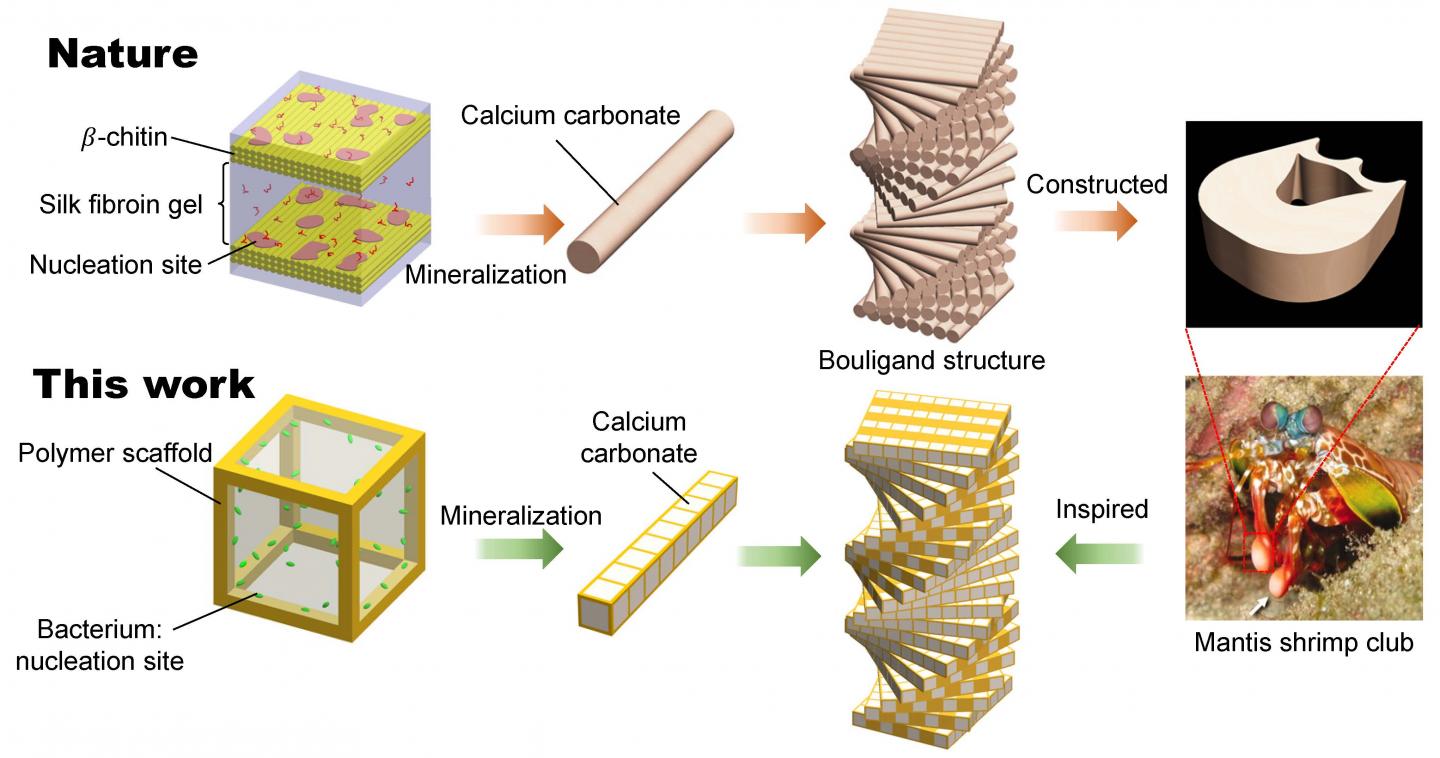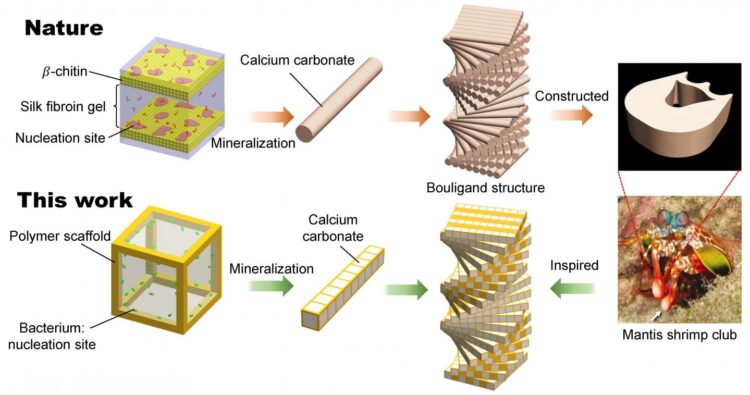USC researchers harness the power of living organisms to make materials that are strong, tolerant and resilient

Credit: Qiming Wang, USC Viterbi School of Engineering
Biological systems can harness their living cells for growth and regeneration, but engineering systems cannot. Until now.
Qiming Wang and researchers at the USC Viterbi School of Engineering are harnessing living bacteria to create engineering materials that are strong, tolerant, and resilient. The research is published in Advanced Materials.
“The materials we are making are living and self-growing,” said Wang, the Stephen Schrank Early Career Chair in Civil and Environmental Engineering and assistant professor of civil and environmental engineering in the Sonny Astani Department of Civil and Environmental Engineering (CEE). “We have been amazed by the sophisticated microstructures of natural materials for centuries, especially after microscopes were invented to observe these tiny structures. Now we take an important step forward: We use living bacteria as a tool to directly grow amazing structures that cannot be made on our own.”
The researchers work with specific bacteria– S. pasteurii–known for secreting an enzyme called urease. When urease is exposed to urea and calcium ions, it produces calcium carbonate, a fundamental and strong mineral compound found in bones or teeth. “The key innovation in our research,” said Wang, “is that we guide the bacteria to grow calcium carbonate minerals to achieve ordered microstructures which are similar to those in the natural mineralized composites.”
Wang added: “Bacteria know how to save time and energy to do things. They have their own intelligence, and we can harness their smartness to design hybrid materials that are superior to fully synthetic options.
Borrowing inspiration from nature is not new in engineering. As one would suspect, nature has great examples of complex mineralized composites that are strong, fracture resistant, and energy damping–for example nacre or the hard shell surrounding a mollusk.
Wang said: “Although microorganisms such as bacteria, fungi and viri are sometimes detrimental in causing diseases–like COVID-19–they can also be beneficial. We have a long history of using microorganisms as factories–for example, using yeast to make beer. But there is limited research on using microorganisms to manufacture engineering materials.”
Combining living bacteria and synthetic materials, Wang said this new living material demonstrates mechanical properties superior to that of any natural or synthetic material currently in use. This is largely due to the material’s bouligand structure, which is characterized by multiple layers of minerals laid at varying angles from each other to form a sort of “twist” or helicoidal shape. This structure is difficult to create synthetically.
Wang worked in collaboration with USC Viterbi researchers An Xin, Yipin Su, Minliang Yan, Kunhao Yu, Zhangzhengrong Feng, and Kyung Hoon Lee. Additional support was provided by Lizhi Sun, professor of civil engineering at the University of California, Irvine, and his student Shengwei Feng.
What’s in a Shape?
One of the key properties of a mineralized composite, Wang said, is that it can be manipulated to follow different structures or patterns. Researchers long ago observed the ability of a mantis shrimp to use his “hammer” to break open a muscle shell. Looking at his “hammer”–a club-like structure or hand–more closely, they found it was arranged in a bouligand structure. This structure offers superior strength to one arranged at more homogenous angles–for example alternating the lattice structure of the material at 90 degrees with each layer.
“Creating this structure synthetically is very challenging in the field,” Wang said. “So we proposed using bacteria to achieve it instead.”
In order to build the material, the researchers 3-D printed a lattice structure or scaffolding. This structure has empty squares within it and the lattice layers are laid at varying angles to create scaffolding in line with the helicoidal shape.
The bacteria are then introduced to this structure. Bacteria intrinsically like to attach to surfaces and will gravitate to the scaffolding, grabbing on to the material with their “legs.” There the bacteria will secrete urease, the enzyme which triggers formations of calcium carbonate crystals. These grow from the surface up, eventually filling in the tiny squares or voids in the 3-D printed lattice structure. Bacteria like porous surfaces, Wang said, allowing them to create different patterns with the minerals.
The Trifecta
“We did mechanical testing that demonstrated the strength of such structures to be very high. They also were able to resist crack propagation–fractures–and help dampen or dissipate energy within the material,” said An Xin, a CEE doctoral student.
Existing materials have shown exceptional strength, fracture resistance, and energy dissipation but the combination of all three elements has not been demonstrated to work as well as in the living materials Wang and his team created.
“We fabricated something very stiff and strong,” Wang said. “The immediate implications are for use in infrastructures like aerospace panels and vehicle frames.”
The living materials are relatively lightweight, also offering options for defense applications like body armor or vehicle armor. “This material could resist bullet penetration and dissipate energy from its release to avoid damage,” said Yipin Su, a postdoc working with Wang.
There’s even potential for these materials to be reintroduced to bacteria when repairs are needed.
“An interesting vision is that these living materials still possess self-growing properties,” Wang said. “When there is damage to these materials, we can introduce bacteria to grow the materials back. For example, if we use them in a bridge, we can repair damages when needed.”
###
Media Contact
Amy Blumenthal
[email protected]
Related Journal Article
http://dx.





